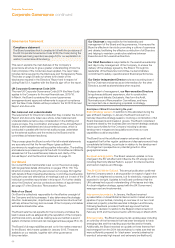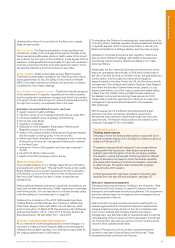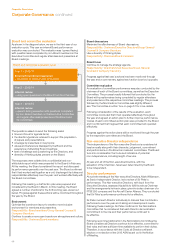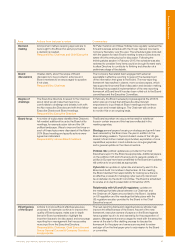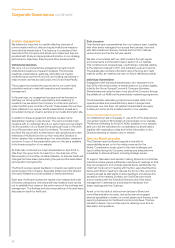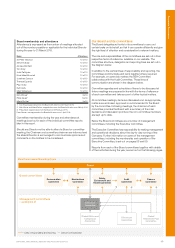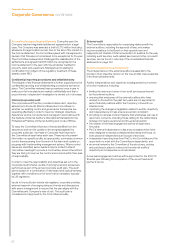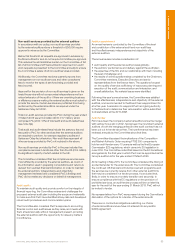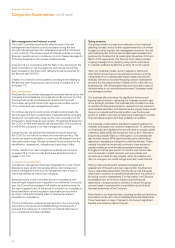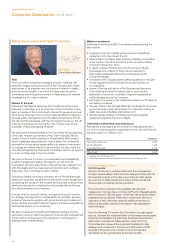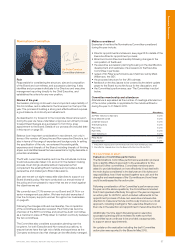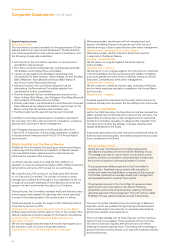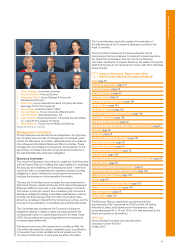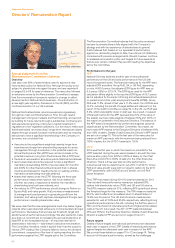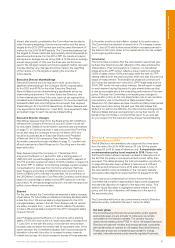National Grid 2015 Annual Report Download - page 56
Download and view the complete annual report
Please find page 56 of the 2015 National Grid annual report below. You can navigate through the pages in the report by either clicking on the pages listed below, or by using the keyword search tool below to find specific information within the annual report.
Corporate Governance
Corporate Governance continued
Going concern
Our going concern process is an extension of our business
planning process, and is further supplemented by our annual
budget and other liquidity risk management controls. Our five
year business plan and one year budget were reviewed and
approved by the Board at its meetings in November 2014 and
March 2015 respectively. The Finance Committee provides
ongoing oversight of our liquidity policy, which requires us
tomaintain sufficient liquidity for a rolling 12 month period.
Given our business model, current regulatory clarity and
otherfactors impacting our operating environment, and the
robustness of our business planning process and scenario
analysis, we have concluded the going concern assessment
period is the five years ending 31 March 2019, in line with our
business plan. We will reassess this period annually in light of
developments in our operating environment, business model
and strategic priorities.
Our business plan considers the significant solvency and
liquidity risks involved in delivering our business model in light
ofour strategic priorities. The business plan models a number
ofupside and downside scenarios, derived from the risks and
opportunities identified, and determines the impact these would
have on our results and financial position over the five year
period. In addition, we have reviewed and challenged a number
of worst case scenarios and their possible remediation.
Our business model calls for significant capital investment to
maintain and expand our network infrastructure. To deliver this,
our business plan highlights that we will need to access capital
markets to raise additional funds from time to time. We have a
long and successful history in this regard. Our business plan
also models various KPIs used by lenders and credit rating
agencies in assessing a company’s credit worthiness. These
models indicate that we should continue to have access to
capital markets at commercially acceptable interest rates
throughout the five year period. To monitor and control risks
around access to capital markets, we have policies and
procedures in place to help mitigate, as far as possible, any
riskof a change in our credit ratings and other credit metrics.
Having made enquiries and reviewed management’s
assessment of the going concern assumption, the Directors
have a reasonable expectation that the Group has adequate
resources to continue in operational existence for the period of
the going concern assessment. For this reason, the Directors
are satisfied that, at the time of approving the financial
statements, it is appropriate to continue to adopt the going
concern basis in preparing the consolidated and individual
financial statements of the Company.
More detail on our financial risks, including liquidity and solvency,
is provided in note 30 to the consolidated financial statements.
There have been no major changes to the Group’s significant
liquidity and solvency risks in the year.
Risk management and internal control
The Audit Committee monitors the effectiveness of the risk
management and internal control processes during the year
through the biannual reports it receives and reports to the Board
on the outcome. The review covers all material controls, including
financial, operational and compliance controls. Please see page 41
for further details about the review of effectiveness.
In support of our compliance with the New Code, reporting to the
Audit Committee on risk management and internal control has
been reviewed by the Board and refinements will be adopted for
the financial year 2015/16.
Details of our internal control systems, including those relating to
the financial reporting process, can be found on pages 38 to 41
and page 173.
Risk management
The Executive Committee discusses the principal risks faced by the
Company and updates the corporate risk profile every six months.
The approved profile is subsequently shared with the Audit
Committee, along with US and UK regional risk profiles, as part
ofour continuous risk management process.
To continuously improve and remain at best practice levels, the
riskmanagement team reviews risk process standards, emerging
trends and concepts being driven by the main consultancy firms
and seeks to apply these as appropriate. The standards issued by
the COSO and the international risk standard ISO 31000 continue
to inform the principles of our risk management process.
During the year, we adopted the revised framework issued by
theCOSO for our internal controls over financial reporting. This
introduced specific principles to cover fraud risk assessment and
information technology. We also reviewed the procedures for the
identification, assessment, mitigation and reporting of risks.
Further details of our risk management systems can be found
onpages 38 to 41 and our risk factors are described in full on
pages 173 to 176.
Compliance management
Compliance management has been integrated into a new Global
Assurance team which incorporates ethics, risk management,
licence management and records management with a view to
improving visibility and reporting in all areas.
Biannual reports to the Committee focus on compliance with
external legal obligations and regulatory commitments. During the
year, the Committee requested that additional detail be added to
the reports against each of the actual or potential non-compliance
items identified to show the person responsible and provide a
summary of the actions being taken to resolve the actual or
potential non-compliance.
The Committee also received annual reports on the Company’s
anti-bribery procedures and whistleblowing procedures and
reviewed their adequacy. It noted that no material instances of
non-compliance had been identified.
54


